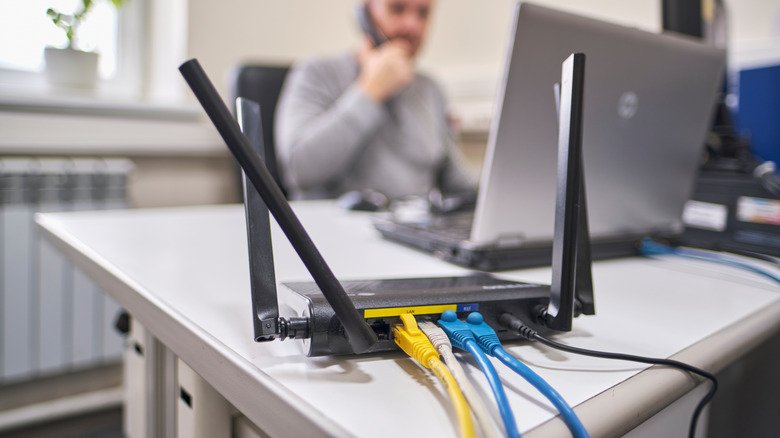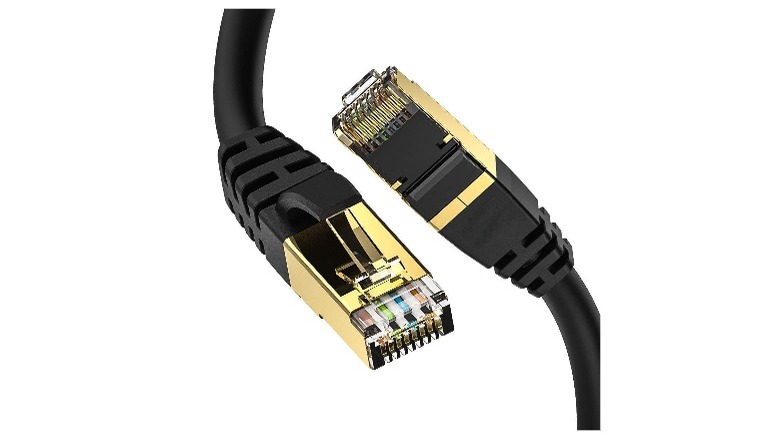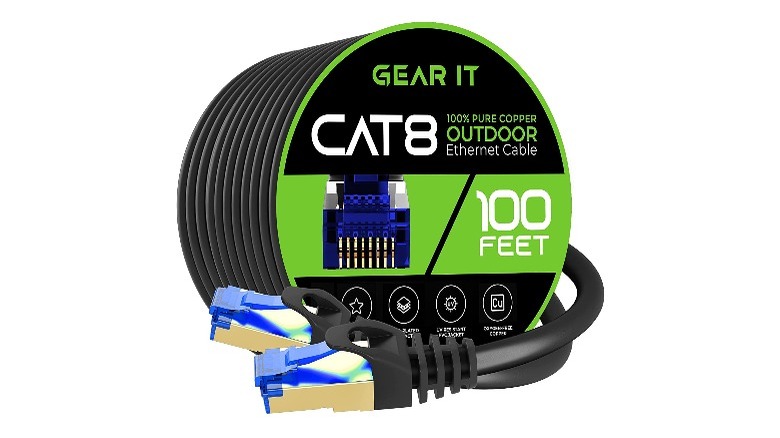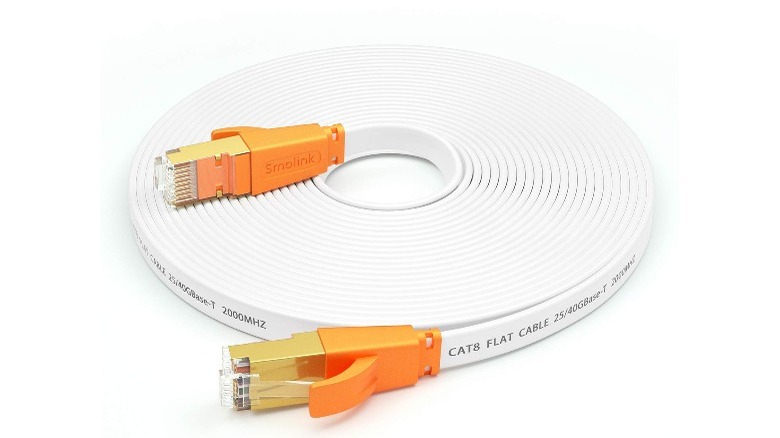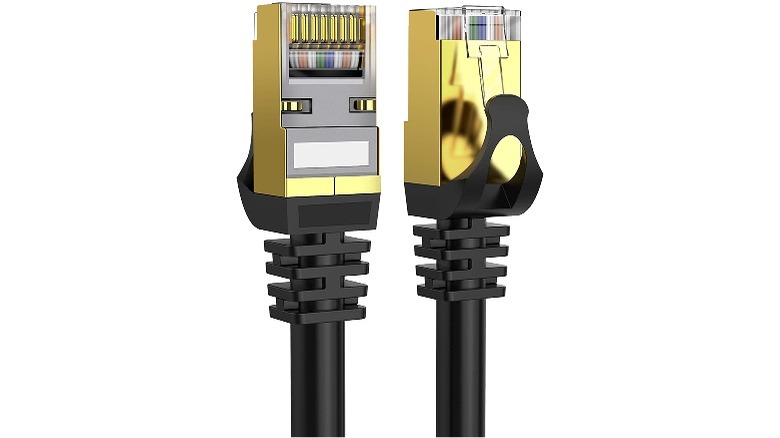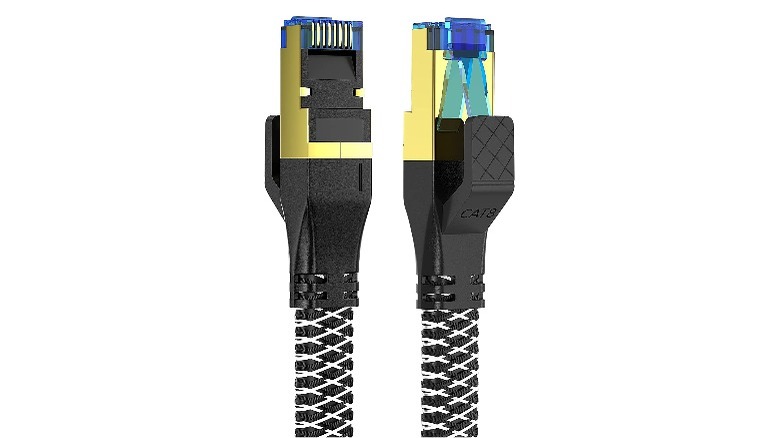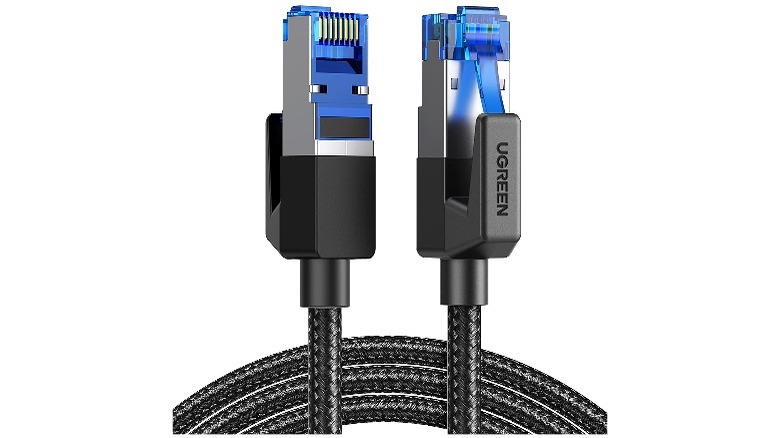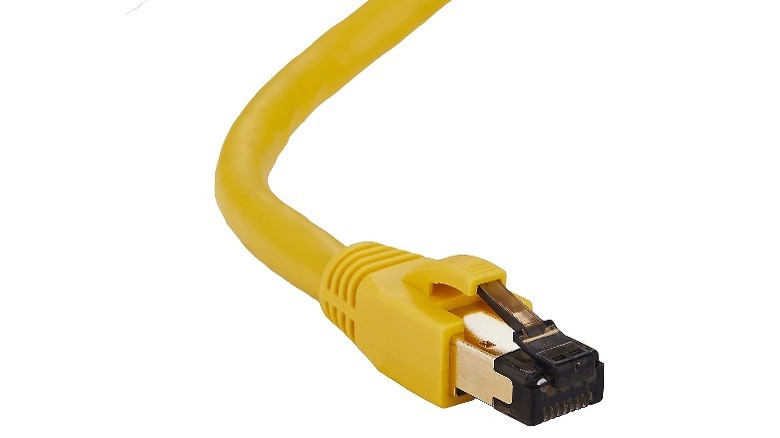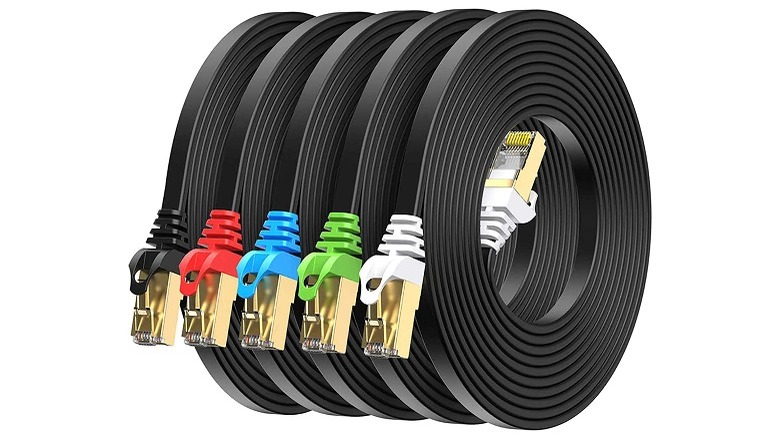The 8 Best Cat-8 Ethernet Cables For Home Networking
We may receive a commission on purchases made from links.
When it comes to high-speed data transfer, Cat-8 Ethernet cables are the gold standard at present. They're not only the fastest but also the most resilient, often featuring protective coatings designed to withstand the challenges that come with both indoor and outdoor use. It's easy to forget about your Ethernet cable when upgrading your home networking setup, but if you've been relying on the same tired cables for years now, upgrading to the latest cables could make a big difference to your connection speed.
There are countless different Cat-8 Ethernet cables on the market to choose from, and it's easy to get lost in the clutter. That's why we've picked out eight of our top picks, all of which offer optimal speed, class-leading resilience, and some handy extra features that might make cable management that bit easier as well. Whether you're a gamer, remote worker, or simply want to upgrade your network, these top performers should have you covered.
DBillionDa Cat-8 Ethernet Cable
The Cat-8 cable from DBillionDa is a great all-rounder, with a plain black plastic jacket that'll fit in anywhere from your gaming setup to a home office. That jacket is also resilient enough for the cable to support direct burial if needed, with protection against common outdoor hazards like water ingress and plant growth. Like most Ethernet cables of this nature, the DBillionDa comes with RJ45 connectors at both ends. This means it'll fit most common devices, including game consoles, desktop PCs, smart TVs, and servers.
It supports speeds of up to 40Gbps and bandwidth up to 2000MHz, which is more than you're ever likely to need for most home networks. Even so, there's no real way to "overdo" a cable's capacity, and buying a cable like this will surely futureproof your setup for years to come. The Cat-8 cable is available in a wide variety of lengths, from 1.5 feet to 150 feet. Most buyers looking to connect their games console or home office probably won't need much longer than 6 feet in length, which can be picked up for just $8.99 on Amazon as of this writing.
GearIt Outdoor Cat-8 Ethernet Cable
As its name suggests, the GearIt Outdoor Cat-8 ethernet cable is the best choice if you're looking for a longer-length cable to connect a garage or outbuilding to your home network. The PVC outer shell is designed to withstand anything the outdoors can throw at it, and it can be buried too. It's UV resistant, waterproof, resistant to extreme temperatures, and resistant to outside electromagnetic interference. On either end is an RJ45 connector with gold plating that's 50 microns thick.
It's compatible with less capable cables too, so you can chain it with a Cat-5, Cat-6, or Cat-7 cable without issue. A range of lengths are available, from 25 feet up to 100 feet. In its longest form, the cable costs $69.99, making it a little pricier than some of its rivals, but still more capable than almost all of them. If you don't need so much length, then the 25-foot-long variant can be picked up for a much more budget-friendly $24.99.
Smolink Flat Cat-8 Ethernet Cable
Cables are still the fastest and most reliable form of data transmission, but one of their biggest disadvantages compared to wireless transfer is that they can often be bulky and look unsightly if you're running them across a room. Smolink aims to solve those issues with its flat Cat-8 Ethernet cable, which sports the same 40Gbps, 2000MHz specs as its rivals, but measures in at just a few millimeters thick.
This means it can fit through narrow spaces that round cables wouldn't be able to, making it an excellent choice for tight-fitting or awkward cable setups. It's also great if you're looking to install the cable under carpets or floors, and it's pull resistant so you won't have to worry about any untimely breakages. Smolink claims that the cable can also withstand weights of up to 55 pounds without issue. Length ranges from 3 feet to 200 feet, with a mid-length 20-foot cable currently available for $12.99.
Dacrown Cat-8 Ethernet Cable
While it's not as feature-packed as some of the other Ethernet cables on this list, the Dacrown Cat-8 Ethernet cable packs all the essentials for a very reasonable price. That includes a pure copper core, 50-micron gold-plated connectors, and a resilient PVC outer cover that can be installed both indoors and outdoors. It's also bite-proof, so inquisitive pets won't be an issue.
The cable utilizes both an aluminum shield and a woven mesh shield to minimize interference, both from outside sources and from other wires within the cable. It's also one of the plainest-looking wires of its kind, but that's a good thing in this case. It means it'll blend in with nearly every tech setup, which comes in especially handy if you're looking to connect a device where appearances make a difference, such as a smart TV or home desktop. Like most of the other Ethernet cables here, the Dacrown is available in many lengths, from 1.5 feet to 150 feet. Most home tech setups will need a cable on the shorter end of that range, with the 3-foot-long cable retailing for $10.99 as of this writing.
YSong Woven Cat-8 Ethernet Cable
The YSong Cat-8 Ethernet cable is about as cheap as you'll get for a decent cable of its kind, but that's no bad thing. It features a woven nylon jacket in place of the usual PVC, which helps prevent kinks and tangling. The nylon threads form a black-and-white cross pattern across the cable, making it look a little funkier than your standard black plastic cable too if that's your thing. While it can't claim to be as slimline as rivals from the likes of Smolink, the YSong is still flatter than average thanks to its rounded rectangular shape.
The YSong ranges in length from 6 feet all the way up to 200 feet, the latter of which will likely be overkill for a home setup, especially since this cable isn't suitable for outdoor use. In six-foot form, it retails on Amazon for $5.99, but at the time of writing, it's on sale for just $3.99.
UGreen Cat-8 Ethernet Cable
If a nylon-wrapped cable seems a little too basic, then the UGreen Cat-8 Ethernet cable is a more upmarket option. Wrapped in black braided cotton, it features four shielded foiled twisted pairs and an extra aluminum foil shielding layer for minimal interference. Like all good cables of this nature, the wires are made from 100% pure copper, and at both ends there are gold-plated connectors. The cable is perfectly round, with a width of 9.9 millimeters, which is a little too wide to fit under most carpets and flooring.
Not that you'd want to hide the UGreen away anyway, as its premium-looking design makes it a solid option for games consoles, home office setups, or really anywhere where it'll be on show. While its cotton jacket might look good, it does mean that the cable isn't suitable for heavy-duty or outdoor use. Available lengths stretch from 3 feet to 65 feet, with a 6-foot cable available for a retail price of $15.99.
Cables Direct Online Cat-8 Ethernet Cable
While most Ethernet cables come with designs that could easily blend into home or office setups, the Cat-8 cable from Cables Direct Online is designed to stick out from the rest. It's available in a range of bright colors including yellow, orange, green, and blue, so you'll always be able to keep track of it if you've got lots of different cables to contend with. It packs oxygen-free copper wires and 24-karat gold connectors, alongside industry-standard protection against electromagnetic and radio interference.
It's also one of the shortest cables on the market, with a length of just 0.5 feet in its smallest form. That's great if you have a compact setup and want something that won't get tangled up with other wiring. The 0.5-foot long cable is available for $6.95, while a longer 3-foot cable can be picked up for just a dollar more at $7.95 retail price.
Busohe Cat-8 Ethernet Cable 5-Pack
If you're in need of several different Cat-8 Ethernet cables and you don't want to get them confused, then you have a couple of options. You could buy multiple different colors of the cables sold by Cables Direct Online, but then you'll end up with a rainbow mass of cabling that might look unsightly depending on the color combinations you end up with. The alternative (and arguably, much better) option is to buy a five-pack of Cat-8 cables from Busohe, each of which comes with handy color-coded connectors so you can easily differentiate them.
The cables themselves, however, are much more subtle — think black PVC jackets and a flattened design. They still offer up to 40Gbps speed and up to 2000MHz bandwidth, and the RJ45 connectors are gold-plated to 50 microns thick. With a range from 1 foot to 50 feet in length, a five-pack of 5-foot-long cables is available for $20.99 on Amazon.
